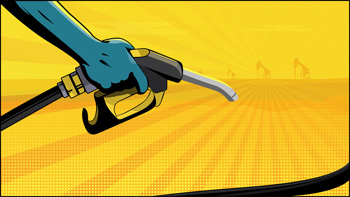Historically, gas prices climb in the spring for a variety of reasons that include the switchover to summer-blend fuel. Then they decline in the fall due to reasons like decreasing demand for gas after the warm summer months.
But that’s not happening this year. Gas prices have been rising and naturally drivers are upset. What’s going on?
 In short, as always, it’s about oil prices, which are the dominant factor in the price of a gallon of gasoline. On October 20, oil prices were around $85 per barrel. Exactly two months earlier, they were $65 per barrel. There are 42 gallons in a barrel of oil, so every dollar increase in a barrel equates to about 2.4 cents per gallon.
In short, as always, it’s about oil prices, which are the dominant factor in the price of a gallon of gasoline. On October 20, oil prices were around $85 per barrel. Exactly two months earlier, they were $65 per barrel. There are 42 gallons in a barrel of oil, so every dollar increase in a barrel equates to about 2.4 cents per gallon.
Oil prices have gone up 48 cents per gallon in the past two months. During this time gas prices have increased 15 cents—from $3.17 to $3.32 per gallon, according to weekly data from the U.S. government.
So, if gas prices track oil prices, which are up the equivalent of 48 cents per gallon, why are gas prices “only” up 15 cents? There are several extenuating circumstances.
First, August and September are the last two months of the year that require summer-blend fuel, which is more expensive to produce. This seasonal transition around Labor Day tends to lead to a gas price decrease of 5 to 10 cents per gallon.
Second, retailer gross margins on fuels have become tighter, which happens when wholesale prices increase. More than half of all drivers (58%) consider price to be the most important factor in determining where to buy gas. That percentage increases when gas prices go up as the price per gallon becomes a bigger topic in the news and on social media. People will drive further out of their way to save a few cents a gallon and retailers know that. If retailers lose the gas customer, that is also a shopper who may not go inside the store to buy drinks or food. Most retailers will trade a few cents of margin to maintain steady customer traffic.
According to the Oil Price Information Service, retail margins were 25.8 cents per gallon on October 11 (the latest weekly data available), compared to 3.18 cents per gallon on August 16. Gross margins don’t mean gross profits: This is the markup that allows retailers to pay for expenses associated with selling fuel: distribution, credit card fees, rent and utilities, plus profits.
Besides retail gross margins that average about 26 cents per gallon, there are other components in a gallon of gas. There’s taxes, which average about 56 cents per gallon. And there’s the largest cost: the price of oil. At $85 per barrel, oil cost $2.02 per gallon, which will then be refined into gasoline.
Now, no one likes high gas prices, especially the retailers. When gas prices are rising, consumers tend to behave differently, whether it’s buying fewer items inside the store or not at all. The math above shows that retailers aren’t the reason for rising prices. Neither is another guy often blamed: a sitting president of the United States, who does not control gas prices.
It is frustrating that gas prices are about $1.20 higher than they were this time last year, when gas prices were sitting at about $2.15 per gallon. But a lot has changed in the oil markets since March 2020, when the pandemic began taking its toll on the economy. By April, consumer traffic plummeted to such an extent that crude oil traded at around $15 per barrel that month, and for a few hours crude oil futures traded at negative $40. That’s right: Demand for oil was so low that they were giving it away—and offering takers $40 per barrel.
It took more than a year for demand to come back to normal levels. At the same time, less oil is being produced. In some cases, wells that were shut down when oil was $15 a barrel haven’t reopened yet because of cost considerations or a labor shortage. In other cases, OPEC and other oil-producing countries have backed off on increasing production because they like the price of oil now and don’t want to see it drop.
It remains to be seen where oil prices will head over the next few months. But one thing is certain: Today’s gas prices are not rising because of the store down the street—they are rising because of much bigger issues happening around the world.
"gas" - Google News
October 22, 2021 at 11:48PM
https://ift.tt/3C5Uva0
Why Gas Prices Are Rising When They Should Be Falling - NACS Online
"gas" - Google News
https://ift.tt/2LxAFvS
https://ift.tt/3fcD5NP
Bagikan Berita Ini















0 Response to "Why Gas Prices Are Rising When They Should Be Falling - NACS Online"
Post a Comment